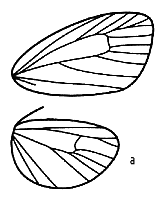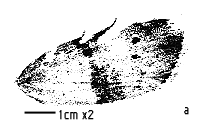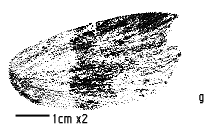|
Stictane
Hampson Gen. rev.
Type
species: fractilinea Snellen, Sumatra.
This
genus has been placed in the Lithosiinae as a synonym of Manoba Walker since Hampson (1914), though Hampson (1900) earlier
placed Manoba as a synonym of Nola.
Manoba was returned to the Nolidae by Holloway & Miller (1995). Stictane
is distinct and genuinely lithosiine.
The
moths are small, grey, with a forewing pattern usually consisting of a darker
grey medial band and blackish spots at the end of the cell and in submarginal
and subbasal rows, usually angled. No veins have been lost from the cells of
either wing, and the radial sector branching system is (R3 (R4, R5)), all the
rest arising independently (Hampson, 1900; Fig 10a).

Fig 10a: Stictane
fractilinea Snellen
The
male genitalia have the uncus long, slender, the valve with the saccular process
shorter than the dorsal part, which is narrow, but variably structured apically.
The aedeagus vesica usually contains cornuti which may be long or short.
The
female genitalia have a short ductus, sometimes with a colliculum, and the
corpus bursae is irregular, containing fields of scobination and often longer
spines. There is usually an appendix bursae.
The
genus needs further disentangling from Manoba
as set out by Strand (1922, Lep. Cat.,
26: 644); indeed, most species listed there under Manoba
and placed in it subsequently are probably misplaced. True Stictane
appears to be Oriental tropical, and probably also includes S. obliquilinea Hampson (Sri Lanka), S. fusca Hampson (Sri
Lanka), S. bipunctulata van
Eecke comb. n., S. umbrata van
Eecke comb. n. (both Sumatra), and the species described below. There are
probably many more undescribed. The genus extends to the Philippines (perhaps Eurosia
costinota Wileman from Mindanao is a Stictane)
and also to Sulawesi (S. rectilinea
Snellen).
The
two Sumatran species (Figs 9a, g) are the most similar in facies to the Bornean
ones, but both have two spots at the end of the cell (obscure in umbrata) as in the type
species, rather than one as in all Bornean species, and strongly bipectinate
male antennae. The medial band of bipunctulata
is narrow anteriorly but very broad over the posterior half. That of umbrata
is broad throughout and diffuses into the distinctly greyer distal half of
the wing. The male genitalia of bipunctulata
(Fig 423) have some features in common with the first two Bornean species
described below, but those of umbrata are
distinctive (Fig 426): the valve is obliquely truncated apically, with a small
spur on the more obtuse dorsal angle; the saccular spine is long but terminates
subapically; the aedeagus is large, the vesica containing eight cornuti (two
groups of three and two single ones).
Bornean
species show some variability in wing markings, so only dissected male specimens
are included in type series except for that of parvipectinata sp. n.
<<Back
>>Forward <<Return
to Contents page
|





